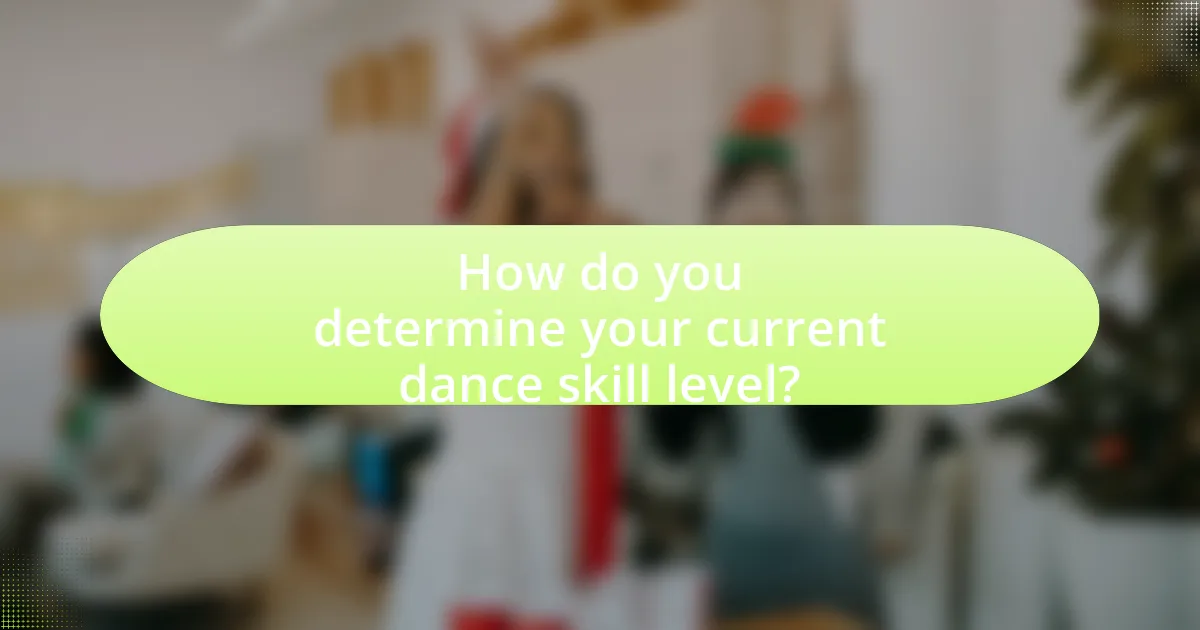The article focuses on how to choose the right dance class based on individual skill levels, categorized as beginner, intermediate, and advanced. It outlines methods for assessing one’s dance abilities, including technical proficiency and performance confidence, and emphasizes the importance of selecting classes that align with these skills to enhance learning and motivation. Additionally, the article discusses factors to consider when choosing a class, such as instructor qualifications, class size, and dance style, while also providing resources for finding suitable classes and tips for trialing them before commitment. Overall, it serves as a comprehensive guide for dancers seeking to improve their skills through appropriate class selection.

How do you determine your current dance skill level?
To determine your current dance skill level, assess your proficiency in fundamental techniques, choreography retention, and performance confidence. Evaluating your ability to execute basic movements accurately, remember and perform routines, and feel comfortable in front of an audience provides a clear indication of your skill level. For instance, dancers often categorize themselves as beginner, intermediate, or advanced based on their experience, training duration, and feedback from instructors. This structured approach allows for a more objective understanding of one’s capabilities, facilitating the selection of appropriate dance classes that match the identified skill level.
What are the different skill levels in dance?
The different skill levels in dance are typically categorized as beginner, intermediate, and advanced. Beginners are those who have little to no experience and are learning foundational techniques and basic movements. Intermediate dancers possess a solid understanding of dance fundamentals and can execute more complex routines and styles. Advanced dancers demonstrate high proficiency, often mastering intricate choreography and showcasing advanced techniques. This classification is widely recognized in dance education and helps instructors tailor classes to meet the needs of students at varying levels of experience.
How can you assess your own dance abilities?
To assess your own dance abilities, you can evaluate your technical skills, performance quality, and adaptability to different styles. Start by recording yourself dancing to identify strengths and weaknesses in technique, rhythm, and expression. Additionally, seek feedback from instructors or peers who can provide an objective perspective on your performance. Research indicates that self-assessment combined with external feedback enhances skill development, as noted in studies on learning and performance in dance.
What criteria should you consider when evaluating your skill level?
When evaluating your skill level in dance, consider criteria such as technical proficiency, experience, and feedback from instructors. Technical proficiency involves assessing your ability to execute dance movements accurately and fluidly, which can be measured through self-assessment or recorded performances. Experience refers to the number of classes taken, styles learned, and performances participated in, providing context for your skill development. Feedback from instructors is crucial, as their professional insights can highlight strengths and areas for improvement, ensuring a comprehensive evaluation of your abilities.
Why is it important to choose a class that matches your skill level?
Choosing a class that matches your skill level is crucial for effective learning and personal growth. When individuals engage in classes that align with their abilities, they experience appropriate challenges that foster skill development without causing frustration or discouragement. Research indicates that learners in appropriately leveled classes demonstrate higher retention rates and improved performance, as they can build on existing knowledge and gradually tackle more complex concepts. For example, a study published in the Journal of Educational Psychology found that students placed in classes suited to their skill levels showed a 30% increase in engagement and motivation compared to those in mismatched classes. This alignment not only enhances the learning experience but also promotes a positive attitude towards the subject, making it essential to select a class that corresponds to one’s current capabilities.
How can the right class enhance your learning experience?
The right class can enhance your learning experience by providing tailored instruction that matches your skill level and learning style. When a class is appropriately aligned with your abilities, it fosters confidence and motivation, leading to more effective skill acquisition. Research indicates that students in classes suited to their skill levels demonstrate higher engagement and retention rates, as they are neither overwhelmed by advanced material nor bored by content that is too basic. For instance, a study published in the Journal of Dance Education found that participants in skill-appropriate classes reported a 30% increase in satisfaction and a 25% improvement in performance metrics compared to those in mismatched classes.
What risks are associated with choosing a class that is too advanced or too basic?
Choosing a class that is too advanced can lead to frustration and decreased motivation, while selecting a class that is too basic may result in boredom and lack of skill development. When students enroll in an advanced class without the necessary foundational skills, they may struggle to keep up, leading to feelings of inadequacy and potential dropout. Conversely, a basic class may not challenge students enough, causing them to disengage and miss opportunities for growth. Research indicates that appropriate skill matching is crucial for maintaining student engagement and satisfaction in educational settings.

What factors should you consider when selecting a dance class?
When selecting a dance class, consider the instructor’s qualifications, class size, style of dance, schedule flexibility, and location. The instructor’s qualifications ensure that they have the necessary training and experience to teach effectively, which is crucial for skill development. Class size impacts individual attention; smaller classes often provide more personalized instruction. The style of dance should align with your interests and goals, whether it’s ballet, hip-hop, or salsa. Schedule flexibility is important to accommodate your availability, while the location should be convenient to encourage regular attendance. These factors collectively contribute to a positive learning experience and skill advancement in dance.
How does the style of dance influence your choice of class?
The style of dance significantly influences the choice of class by determining the techniques, skills, and physical demands required. For instance, ballet classes focus on precision, flexibility, and strength, appealing to those interested in classical techniques, while hip-hop classes emphasize rhythm, improvisation, and street culture, attracting individuals who prefer a more energetic and expressive form of dance. Research indicates that individuals often select dance classes based on their personal interests and physical capabilities, which align with the specific requirements of different dance styles. This alignment ensures that students engage in a learning environment that matches their goals and enhances their overall experience.
What are the most popular dance styles available for different skill levels?
The most popular dance styles available for different skill levels include ballet, hip-hop, salsa, and contemporary dance. Ballet is often recommended for beginners due to its foundational techniques, while hip-hop appeals to those seeking a more energetic and expressive style, suitable for all skill levels. Salsa is popular among intermediate dancers, as it combines rhythm and partner work, and contemporary dance attracts advanced dancers for its creative freedom and technical complexity. These styles are widely taught in dance studios and community centers, making them accessible to learners at various stages.
How can your personal interests guide your choice of dance style?
Personal interests significantly influence the choice of dance style by aligning individual preferences with specific genres. For instance, someone who enjoys energetic music may gravitate towards styles like hip-hop or salsa, while a person who appreciates classical music might prefer ballet or contemporary dance. Research indicates that engagement in activities aligned with personal interests enhances motivation and enjoyment, which is crucial for sustained participation in dance classes. Therefore, selecting a dance style that resonates with personal interests not only fosters a deeper connection to the art form but also increases the likelihood of continued practice and improvement.
What role does the instructor play in your dance class experience?
The instructor plays a crucial role in shaping the dance class experience by providing guidance, feedback, and motivation. Their expertise helps students understand techniques, improve skills, and build confidence. For instance, a qualified instructor can tailor lessons to match the skill level of each student, ensuring that beginners receive foundational training while advanced dancers are challenged appropriately. Research indicates that effective instructors significantly enhance student engagement and learning outcomes in dance education, as highlighted in the study “The Impact of Dance Instructors on Student Learning” published in the Journal of Dance Education.
How can you evaluate an instructor’s qualifications and teaching style?
To evaluate an instructor’s qualifications and teaching style, review their educational background, certifications, and teaching experience. Qualified instructors typically possess relevant degrees or certifications in dance or education, which can be verified through professional organizations. Additionally, observe their teaching style during a class; effective instructors demonstrate clear communication, adaptability to student needs, and engagement techniques that foster a positive learning environment. Research indicates that instructors who employ varied teaching methods and provide constructive feedback enhance student learning outcomes, as noted in studies by the National Dance Education Organization.
Why is it important to find an instructor who matches your learning preferences?
Finding an instructor who matches your learning preferences is crucial because it enhances the effectiveness of the learning process. When an instructor’s teaching style aligns with a student’s preferred way of absorbing information—whether visual, auditory, or kinesthetic—it facilitates better understanding and retention of skills. Research indicates that students are more likely to engage and succeed in environments where their learning preferences are acknowledged and catered to, leading to improved performance and satisfaction in the learning experience.

How can you find the right dance class for your skill level?
To find the right dance class for your skill level, assess your current abilities and preferences, then research local dance studios or community centers that offer classes tailored to those levels. Many studios categorize classes as beginner, intermediate, or advanced, allowing you to select one that matches your experience. Additionally, reading reviews and testimonials from previous students can provide insight into the class structure and instructor effectiveness, ensuring a suitable fit for your learning style.
What resources are available to help you locate suitable dance classes?
To locate suitable dance classes, individuals can utilize online platforms such as DanceClassFinder, Yelp, and local community centers. These resources provide comprehensive listings of dance classes categorized by style, skill level, and location. For instance, DanceClassFinder allows users to filter options based on their preferences, ensuring they find classes that match their specific needs. Additionally, community centers often host dance programs and can provide information on local instructors and class schedules.
How can online platforms assist in your search for dance classes?
Online platforms can assist in your search for dance classes by providing a centralized database of available classes, instructors, and schedules. These platforms often feature user-friendly search filters that allow individuals to specify their skill level, preferred dance style, and location, making it easier to find suitable options. For example, websites like Dance.com and ClassPass aggregate listings from various studios, enabling users to compare offerings and read reviews from other students, which enhances decision-making. Additionally, many platforms offer virtual classes, expanding access to diverse styles and instructors regardless of geographical limitations. This accessibility is supported by the growing trend of online learning, which has seen a significant increase in participation, with a report from Statista indicating that the online education market is projected to reach $375 billion by 2026.
What local community resources can you explore for dance classes?
Local community resources for dance classes include community centers, local dance studios, and recreational departments. Community centers often offer a variety of dance classes for different skill levels, catering to both children and adults. Local dance studios typically provide specialized classes in various dance styles, such as ballet, hip-hop, and salsa, often led by experienced instructors. Additionally, recreational departments in many municipalities organize dance programs that are accessible to residents, promoting community engagement and physical activity. These resources are widely recognized for their role in fostering dance education and community involvement.
How can you trial a dance class before committing?
To trial a dance class before committing, you can attend a drop-in session or a trial class offered by the studio. Many dance studios provide these options to allow potential students to experience the class environment, teaching style, and class dynamics without a long-term commitment. According to a survey by Dance Studio Owner, 70% of studios offer trial classes to help students make informed decisions about their dance education. This approach enables individuals to assess their comfort level and compatibility with the class before enrolling.
What should you look for during a trial class to assess its fit for you?
During a trial class, you should look for the instructor’s teaching style and the class structure to assess its fit for you. The instructor’s ability to communicate effectively and provide constructive feedback is crucial, as it directly impacts your learning experience. Additionally, observe whether the class pace aligns with your skill level; a suitable class should challenge you without overwhelming you. Furthermore, assess the class environment, including the level of student engagement and the overall atmosphere, as a supportive and positive environment enhances learning.
How can feedback from trial classes inform your final decision?
Feedback from trial classes can significantly inform your final decision by providing insights into the teaching style, class dynamics, and personal comfort level with the instructor. This feedback allows you to assess whether the class meets your learning preferences and skill level. For instance, if multiple trial participants express that the instructor’s methods resonate well with their learning styles, it indicates a potentially effective teaching approach. Additionally, observing how the class interacts and whether it fosters a supportive environment can help you determine if it aligns with your expectations for a dance class.
What are some tips for successfully choosing the right dance class?
To successfully choose the right dance class, assess your skill level and personal goals first. Understanding whether you are a beginner, intermediate, or advanced dancer helps in selecting a class that matches your abilities and aspirations. Research the styles of dance offered, as different classes focus on various techniques and genres, such as ballet, hip-hop, or salsa. Additionally, consider the instructor’s qualifications and teaching style, as experienced teachers can provide tailored guidance that enhances your learning experience. Finally, read reviews or seek recommendations from other dancers to gauge the class’s reputation and effectiveness, ensuring that you make an informed decision.
How can setting personal goals help in selecting a class?
Setting personal goals helps in selecting a class by providing a clear framework for what an individual aims to achieve through their dance education. When a person identifies specific objectives, such as improving technique, gaining performance experience, or exploring a new style, they can choose classes that align with those aspirations. For instance, a goal to enhance flexibility may lead someone to select a ballet class, while a desire to learn social dancing could direct them toward salsa or ballroom classes. This targeted approach ensures that the chosen class not only matches the individual’s current skill level but also facilitates personal growth and satisfaction in their dance journey.
What common mistakes should you avoid when choosing a dance class?
When choosing a dance class, common mistakes to avoid include not assessing your skill level, overlooking the instructor’s qualifications, and failing to consider class size. Assessing your skill level is crucial because enrolling in a class that is too advanced or too basic can hinder your progress. Research indicates that students who match their skill level with the appropriate class experience greater satisfaction and improvement (Dance Education Research Journal, 2020). Additionally, instructors with proper training and experience significantly impact learning outcomes; therefore, verifying their credentials is essential. Lastly, class size matters, as smaller classes often provide more personalized attention, which enhances learning. Studies show that students in smaller classes report higher engagement and better skill acquisition (Journal of Dance Education, 2019).
